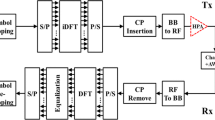Abstract
In this paper, we present an analysis of the BER performance of an ultra-wideband (UWB) system with pulse position modulation (PPM) for data modulation and direct sequence (DS) spreading for multiple access over indoor lognormal fading channels. A rake receiver is used to combine a subset of the resolvable multipath components using the maximal ratio combining technique. Inter-path and multiple-access interferences are modeled and incorporated into the bit-error-rate expressions. The analytical and simulation results allow one to quantify many critical aspects of a DS-PPM UWB system such as the gain of the optimally spaced signaling scheme over the orthogonal signaling scheme, the potential error floor given a specific channel multipath delay spread and the number of interfering users, tolerance of the system to timing jitter, and impact of user codes.
Similar content being viewed by others
References
Win M., Scholtz R. (2000) Ultra-wide bandwidth timing-hopping spread spectrum impulse radio for wireless multiple-access communications. IEEE Transactions on Communications 48: 36–38
Durisi, G., & Benedetto, S. (2003). Performance evaluation and comparison of different modulation schemes for UWB multiaccess systems. In Proceedings of IEEE ICC 2003 (pp. 2187–2191).
Foerster, J. R. (2002). The performance of a direct-sequence spread spectrum ultra-wideband system in the presence of multipath, narrowband interference and multiuser interference. In Proceedings of the 2002 IEEE conference on ultra wideband systems and technologies (pp. 87–91).
Wilson, R. D., & Scholtz, R. A. (2003). Comparison of CDMA and modulation schemes for UWB radio in a multipath environment. Proceedings of IEEE Globecom’03 (pp. 754–758).
Guvenc, I., & Arslan, H. (2003). On the modulation options for UWB systems. In Proceedings 2003 MILCOM.
Ramirez-Mireles, F. (2002). Error probability of ultra wideband SSMA in a dense multipath environment. In Proceedings of MILCOM 2002 (pp. 1081–1084).
Ge, L., Yue, G., & Affes, S. (2002). On the BER performance of pulse-position-modulation UWB radio in multipath channels. In Proceedings of IEEE UWBST’02 (pp. 231–234).
Zhao L., Haimovich A. M. (2002) Performance of ultra-wideband communications in the presence of interference. IEEE Journal on Selected Areas in Communications 20: 1684–1691
Somayazulu, V. S. (2002). Multiple access performance in UWB systems using time hopping vs. direct sequence spreading. IEEE WCNC’02, 2, 522–525.
Intel Research. (2002). Channel modeling sub-committee final report. In IEEE P802.15 working group for wireless personal area networks.
Cassioli D., Win M. Z., Molisch A. F. (2002) The ultra-wide bandwidth indoor channel: From statistical model to simulations. IEEE Journal on Selected Areas in Communications 20: 1247–1257
Molisch A. F., Foerster J. R., Pendergrass M. (2003) Channel models for ultra-wideband personal area networks. IEEE Wireless Communications 10: 14–21
Hashemi H. (1993) Inpulse response modeling of indoor radio propagation channels. IEEE Journal on Selected Areas in Communications 11: 967–978
Scholtz, R. (1993). Multiple access with time-hopping impulse modulation. In Proceedings of MILCOM’93 (Vol. 2, pp. 447–450).
Proakis J. G. (1995) Digital communications (Chap. 14), 3rd edn. McGraw-Hill, New York, NY
Sabattini, M., Masry, E., & Milstein, L. B. (2003). A non-Gaussian approach to the performance analysis of UWB TH-BPPM systems. IEEE UWBST’03, 52–55.
Hu, B., & Beaulieu, N. C. (2003). Precise bit error rate of TH-PPM UWB systems in the presence of multiple access interference. IEEE UWBS’03, 106–110.
Durisi, G., & Romano, G. (2002). On the validity of Gaussian approximation to characterize the multiuser capacity of UWB TH PPM. In Proceedings of IEEE UWBST’02 (pp. 157–161).
Foerster, J. R. (2001). The effects of multipath interference on the performance of UWB systems in an indoor wireless channel. In Proceedings of IEEE VTC 2001–spring (Vol. 2, pp. 1176–1180).
Tian, Z., & Giannakis, G. B. (2003). BER Sensitivity to mis-timing in correlation-based UWB receivers. In Proceedings of IEEE global communications conference (Globecom’03).
Lovelace W. M., Townsend J. K. (2002) The effects of timing jitter and tracking on the performance of impulse radio. IEEE Journal on Selected Area in Communications 20: 1646–1651
Molisch A. F., Cassioli D., Chong C. C., Emami S., Fort A., Kannan B. et al (2006) A comprehensive standardized model for ultrawideband propagation channels. IEEE Transactions on Antennas and Propagation 54: 3151–3166
Author information
Authors and Affiliations
Corresponding author
Rights and permissions
About this article
Cite this article
Magaña, M.E., Liu, H. & Venkatesan, V. Performance of a Binary PPM Ultra-Wideband Communication System with Direct Sequence Spreading for Multiple Access. Wireless Pers Commun 65, 125–142 (2012). https://doi.org/10.1007/s11277-011-0231-9
Published:
Issue Date:
DOI: https://doi.org/10.1007/s11277-011-0231-9




